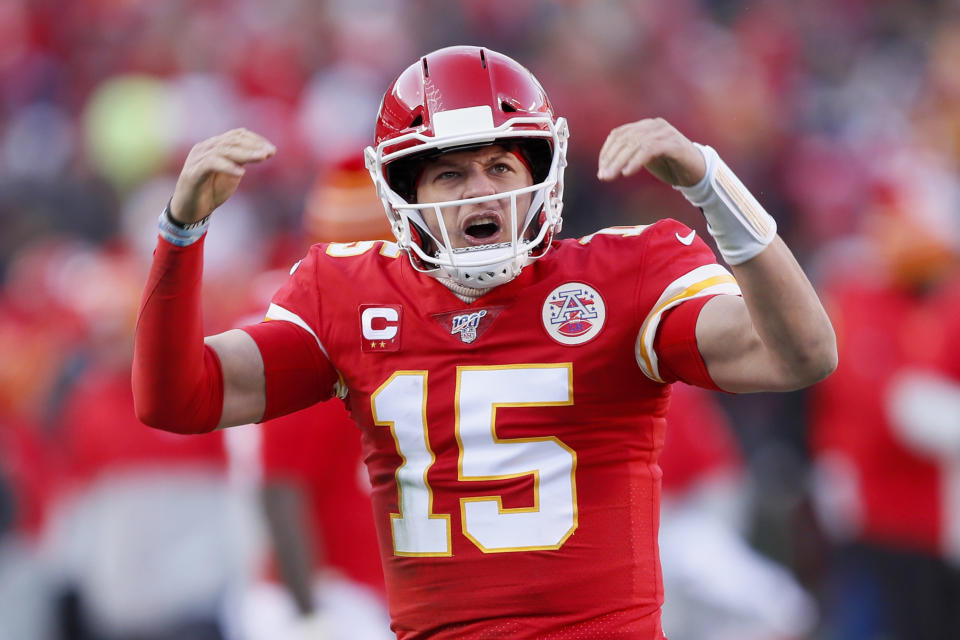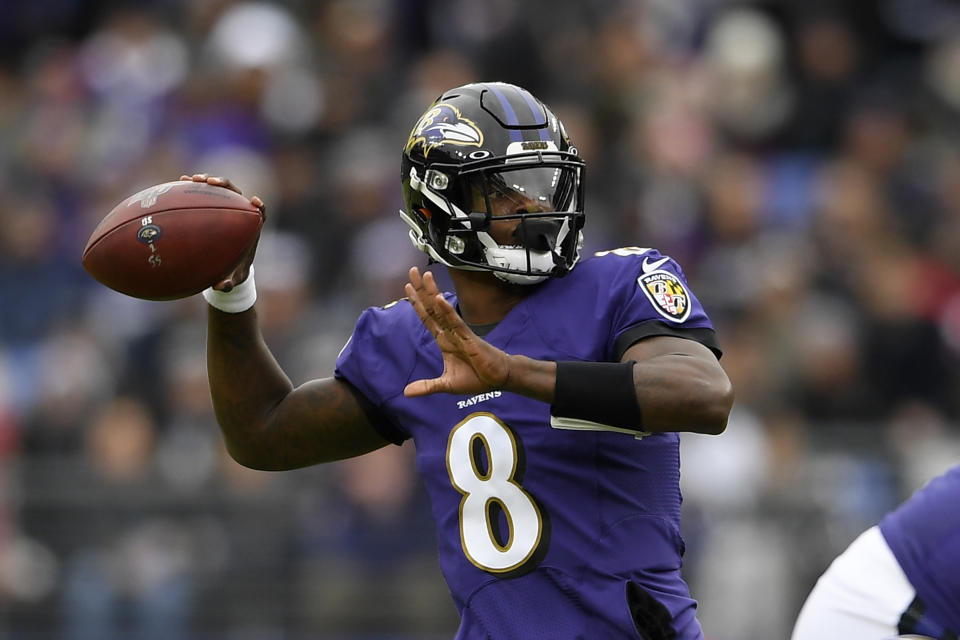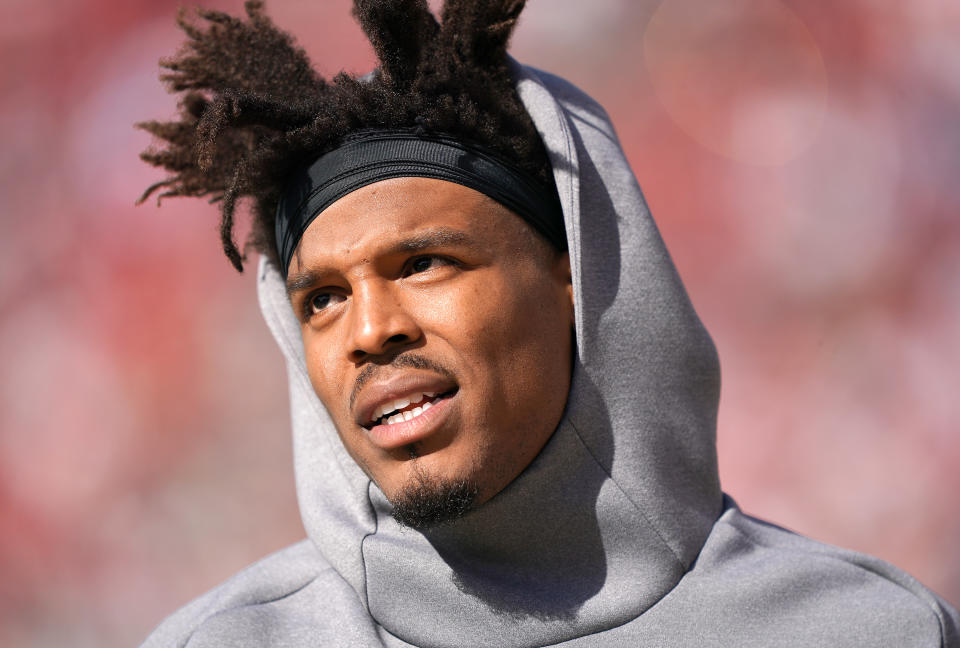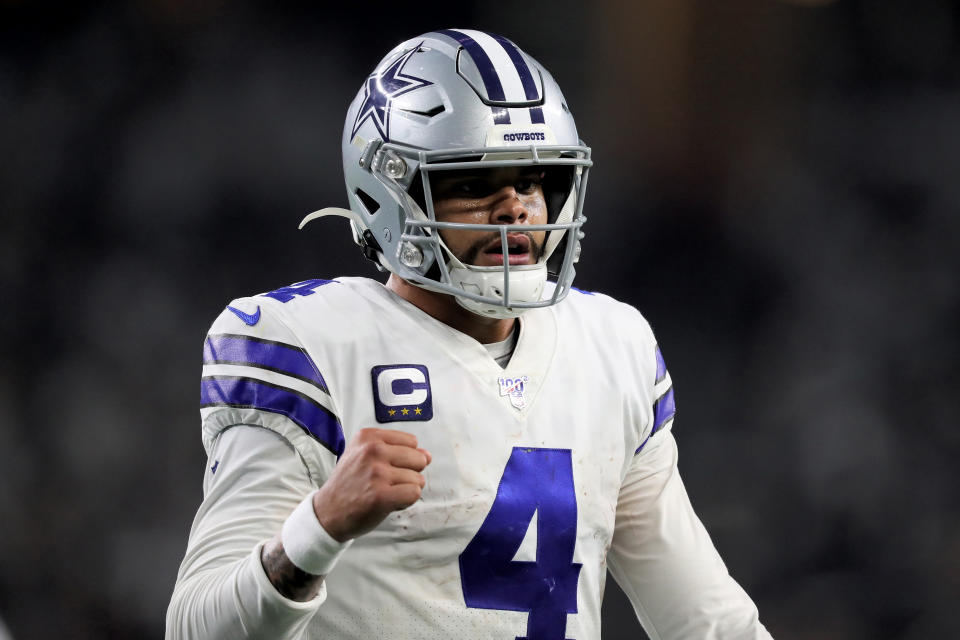NFL quarterback rankings: All 32 starters entering the 2020 NFL season
By Steve Palazzolo
PFF’s quarterback rankings are based on grading every player on every play and tapping into multiple years of data to project future performance. We go beyond last season’s performances, and the grading works to isolate each QB’s performance from that of his supporting cast, making for more effective projections.
In a given year, quarterback performance is somewhat dependent on the pieces around him, and that’s why you annually see traditional statistics fluctuate for the middle class of signal-callers. This concept may be truer than ever, as a large chunk of quarterbacks land in “Tier 3” here, the tier that houses those who are not perennial top-10-caliber quarterbacks but are capable of top-10 production in a given year.
Here are the PFF QB rankings heading into the 2020 season.

TIER 1
High-end quarterbacks who can carry a team. They have high percentages of positively graded plays and limit negatively graded throws, and they’re most likely to achieve high-end passing production no matter their supporting cast.
Patrick Mahomes, Kansas City Chiefs
Mahomes is off to an incredible start to his career, backing up his 2018 MVP campaign with a Super Bowl win. He was lights-out in the first two rounds of the playoffs before overcoming a poor three quarters in the Super Bowl to lead a late comeback for the Chiefs. It’s Mahomes’ fearlessness and quick-strike ability that make him so dangerous, and the playmakers around him allow the Chiefs to take full advantage of his downfield passing ability. With a career’s worth of highlights and a few mistakes for such an aggressive style, Mahomes has taken the mantle as the top signal-caller in the league.
[Create or join a 2020 Yahoo Fantasy Football League for free today]
Russell Wilson, Seattle Seahawks
Until last season, Wilson had a handful of games in which he looked like one of the league’s best, and also a handful in which he was completely off, but the 2019 season saw him eliminate those poor outings en route to the best grade of his career. Wilson has been a top-eight quarterback since entering the NFL in 2012, annually ranking among the league’s best, but he has taken his game to the next level over the past two years.
Will the Seahawks put more on his plate rather than lean on a run-first attack?
While Wilson certainly benefits from heavy play-action and downfield shots that play to his strengths as, perhaps, the best deep-ball thrower in the game, Seattle’s offense could reap the benefits of having the ball in its best playmaker’s hands more often.
TIER 2
Quarterbacks who are more likely to elevate teammates and achieve top-end production, even with lesser supporting casts. Tier 2 QBs have a good chance to rank among the NFL's top-eight quarterbacks — or even finish as the NFL's top signal-caller — in any given year.
Lamar Jackson, Baltimore Ravens
It may be difficult for Jackson to duplicate his incredible statistics from a year ago, as a touchdown rate of 9 percent isn’t sustainable, but he’ll still be one of the league’s most dangerous quarterbacks. His improved accuracy puts defenses in a bind, and the next step in his development will be finding success with passing in come-from-behind situations where conditions are less favorable. Jackson's rushing ability gives him a high floor in any game, as he can make up for bad days as a passer with chunk plays on the ground, and that gives Baltimore a strong baseline from which to work.

Deshaun Watson, Houston Texans
Watson has exhibited the high-end play that gives the Texans something to build around. Now, it’s a matter of avoiding the disastrous games that have plagued him early in his career. Watson creates big plays inside and outside the pocket, but he’ll often try to do too much in the pocket, leading to too many sacks and turnover-worthy plays. The next step for Watson is cutting down on those lulls and taking more “easy” throws to keep the offense on schedule, all while maintaining the highlight-reel plays that will make him a perennial MVP candidate.
Matt Ryan, Atlanta Falcons
It's always easy to overlook how good Ryan has been throughout his career, but as last season showed, disastrous pass-blocking from an offensive line is difficult to overcome. When he’s on his game, Ryan is one of the league’s best intermediate (10-19 yard) passers and generally takes good care of the ball. Ryan, who was still a capable passer from a clean pocket in 2019, could benefit massively from even a slight improvement in his line's blocking in 2020.
Tom Brady, Tampa Bay Buccaneers
There’s no denying that Brady didn’t look like himself last season, but when combined with a poor group of playmakers, the results were ugly. That’s what makes this year so fascinating, as Brady is equipped with one of the NFL's best groups of receivers and tight ends, though he’s about to learn a new offensive system for the first time in 20 years. Brady’s ability to mesh with head coach Bruce Arians is crucial, and if it’s a quick learning curve, the production should be there. Even at age 43, he’s still one of the league’s most accurate passers and can be counted on to make good decisions while limiting turnovers.
Drew Brees, New Orleans Saints
As we saw last season, Brees' accuracy remains top-notch. And there’s not much he hasn’t seen from under center, so that baseline already gives him a good chance of success in 2020. It’s safe to predict that Brees will rank among the league’s best at avoiding negatively graded throws once again, but keep an eye on the positively graded throws and the downfield passing, as that will determine how much success the Saints have during the stretch run this season.
Aaron Rodgers, Green Bay Packers
Will a more run-heavy approach get the most out of him in his later years?
That appears to be the Packers' plan given their draft strategy of adding run-game weapons instead of upgrading the wide receivers room, and perhaps that will play to Rodgers’ strengths of getting the ball down the field. He’s still capable of making the special throws and avoiding the disastrous ones — an excellent starting point for any QB — but Rodgers ranks just 26th in accuracy percentage on 1-19-yard throws over the past two years, so perhaps the Packers see this as an opportunity to take some of those plays off his plate.
TIER 3
Volatile or conservative quarterbacks who will rely even more heavily on supporting cast and play-calling. Tier 3 quarterbacks can post top-10 production in any given year in the right situation.
Cam Newton, New England Patriots
Newton is incredibly talented, and while many point to his 2015 MVP season, that year was an outlier in his career. He has been an above-average quarterback in his nine years but has ranked in the 20s in PFF grading in each of the past three seasons. Part of that was due to Injuries and the fact that early 2018 Newton was a change from the previous, downfield-throwing boom or bust passer who hit great throws but also missed far too many.
While Newton’s early 2018 numbers were inflated, it showed his ability to play a more ball-control style — perhaps the desired approach for the Patriots' offense. Newton’s rushing ability is another factor for the Patriots to tap into, and given his one-year contract, they could look to use it to its fullest.

Joe Burrow, Cincinnati Bengals
It’s a new era in Cincinnati with No. 1 overall pick Joe Burrow taking over after posting the highest single-season grade of the PFF college era. Burrow’s accuracy, pocket presence and overall playmaking ability made him the best prospect in the draft, and he has the skills to produce at the next level. While Burrow was surrounded by outstanding talent at LSU, his 2019 season may be the best in college football history, as he never had a down game and elevated his play as the season progressed.
Ryan Tannehill, Tennessee Titans
There’s no denying that Tannehill’s 2019 season was a far cry from the rest of his career. Even if this is a turning point in his development, it will still be difficult for him to duplicate the on-field production that carried the Titans’ offense last season. That said, Tannehill has always been an accurate quarterback at the short and intermediate levels. Deep passing success is often down to the supporting cast, and that’s where wide receiver A.J. Brown provides hope.
Derek Carr, Las Vegas Raiders
There’s no denying Carr’s ability to throw accurately and with the requisite amount of velocity to every level of the field. That’s why I’ve advocated for a more aggressive approach to maximize the offense’s effectiveness. The Raiders' offensive weapons aren’t great, but the pieces are improving. If Carr takes advantage, he’s capable of posting a top-10 season.
Jared Goff, Los Angeles Rams
Goff’s critics will point to last season as his regression, but the reality is that he has played like a mid-tier quarterback whose production has been dependent on his ecosystem. We’ve seen Goff make a high percentage of big-time throws while efficiently attacking the intermediate level, and he’s primed to bounce back as long as the offensive line returns to form and a third wide receiver emerges as a vertical threat.
Jimmy Garoppolo, San Francisco 49ers
Garoppolo finished with the 13th-best grade in the league during the regular season, and that’s a fair proxy for what he is at this point in his career. Garoppolo’s accuracy helps make the system work, as he had the sixth-lowest percentage of uncatchable passes a year ago, though he must cut down on those poor decisions over the middle of the field that turned too many of his solid games into average performances.
Kirk Cousins, Minnesota Vikings
Cousins was one of the most efficient quarterbacks in the league last season, producing a career-high 84.1 overall grade, including the playoffs. He made big plays outside the pocket, and while the new system certainly provided more downfield opportunities, Cousins also did a fine job of keeping the offense on point despite injuries on the outside and uneven play from the offensive line.
Dak Prescott, Dallas Cowboys
With Prescott playing on the franchise tag, we see the dilemma with locking up a quarterback who is not in the top echelon every season. Prescott has two top-10 finishes in PFF grades, and the Dallas pass game was excellent last season. With most of the same pieces returning, the table is set for another productive pass game, and that’s all that matters when building an offense. With the top receiving unit and one of the league’s best offensive lines, expect another good year from Prescott and another debate about his long-term value a year from now.

Matthew Stafford, Detroit Lions
Stafford getting back to a downfield attacking machine is a great sign for the Lions, and that should be their approach in 2020. There are a handful of games each year in which Stafford looks like a top-five QB, using his strong arm and playmaking feel to make “wow” plays all over the field. While it’s not easy to bottle that up and trot it out there for 16 games, a more aggressive, downfield-throwing Stafford has a much better chance of unlocking that potential, and the Lions have the skill position talent to put points on the board.
Carson Wentz, Philadelphia Eagles
Looking at Wentz’s first four NFL seasons, we see a quarterback who ranks in the top half of the league, though his 2017 MVP hype was a sign of his ceiling, not his norm. When aided by a solid group of playmakers, he’ll give them ample opportunities to make plays. The Eagles have made moves to put those playmakers in place, so this could be another big statistical season for Wentz.
Ben Roethlisberger, Pittsburgh Steelers
We saw only one game from Roethlisberger last season, and it was not his best effort — he graded at just 49 overall. Any time Roethlisberger is on the field, he’s capable of carrying a team and putting his playmakers in position to succeed, but there are also many signs from his 2018 and limited 2019 on-field play that are cause for concern.
Baker Mayfield, Cleveland Browns
It’s a pivotal year for Mayfield after he took a downturn last season. The Browns are surrounding him with an improved offensive line and a new offensive system to go with a strong group of pass-catchers at all levels of the field. Mayfield’s 2019 season wasn’t as bad as the stats showed, but there was a clear dropoff in his performance.
Philip Rivers, Indianapolis Colts
It will be a new world for Rivers in 2020 — he’s playing behind a good offensive line for the first time in years, and having a bigger pocket to maneuver around should work wonders. Rivers leaves one of the better receiving units to throw to a corps that consists of T.Y. Hilton plus young question marks. If the youth develops, Rivers playing indoors behind a strong offensive line should put the Colts in position to win plenty of games, and it would not surprise to see another one-year rejuvenation to his career.
TIER 4
Quarterbacks with more question marks, either due to a lack of experience/seeing them perform at a high level in the NFL or due to volatility when given extended opportunities to play.
Ryan Fitzpatrick, Miami Dolphins: With the Dolphins spending the fifth overall pick on Tua Tagovailoa, expect him to start as soon as possible.
Josh Allen, Buffalo Bills: Since drafting Allen in 2018, the Bills have done a great job of building their offense around him, and he’s in position to have a big statistical season in 2020.
Sam Darnold, New York Jets: It’s a pivotal year for Darnold, who has shown the peaks of a franchise signal-caller but also the valleys of a backup.
Gardner Minshew, Jacksonville Jaguars: This season is another test for Minshew to see if he can elevate the offense and build on the downfield accuracy and decision-making that made him so efficient last season.
Drew Lock, Denver Broncos: It’s far too early to declare Lock as the future for the Broncos, even with his 4-1 record, but the offseason additions in Denver will give him every opportunity to succeed.
Tyrod Taylor and Justin Herbert, Los Angeles Chargers: Taylor is one of the league’s best at avoiding turnover-worthy throws, but that comes in exchange of taking too many sacks. Given the unique offseason circumstances, this could be a perfect opportunity for Herbert to sit and learn.
Teddy Bridgewater, Carolina Panthers: Bridgewater will get that chance to start, and we’ll see if he can take another step beyond the game manager label.
Kyler Murray, Arizona Cardinals: Murray’s athleticism brings a baseline of production to the offense in the running game, and the better supporting cast should lend itself to a better season in Year 2.
Daniel Jones, New York Giants: One of Jones’ best attributes is his willingness to create big plays when under pressure, and that can sometimes lead to spectacular plays as well as disastrous ones.
Dwayne Haskins, Washington Football Team: The new coaching staff will be eager for him to play a tick faster, and they'll no doubt be looking to find another playmaker for Haskins to trust outside of wide receiver Terry McLaurin.
Nick Foles and Mitchell Trubisky, Chicago Bears: Foles gives the Bears the best opportunity for high-end play, but he’s also dabbled in a “game manager” role at points in his career.
For more NFL statistical analysis, go to PFF.com.
More from Yahoo Sports:

